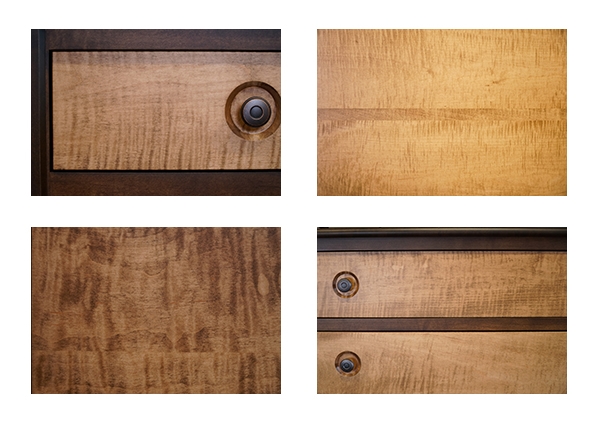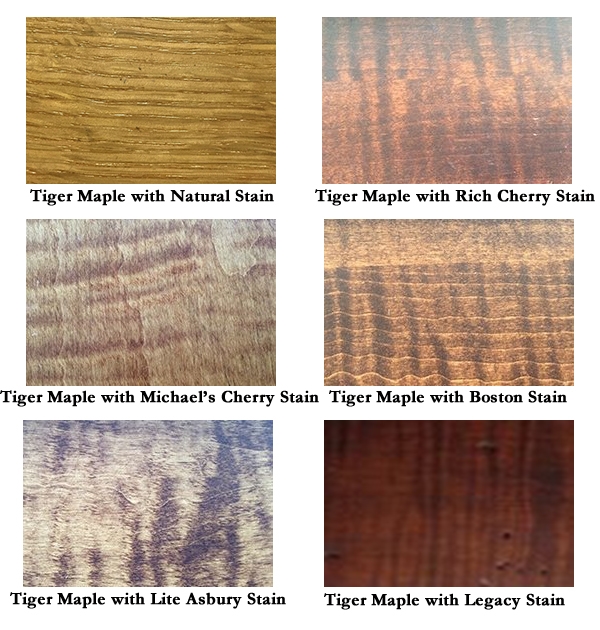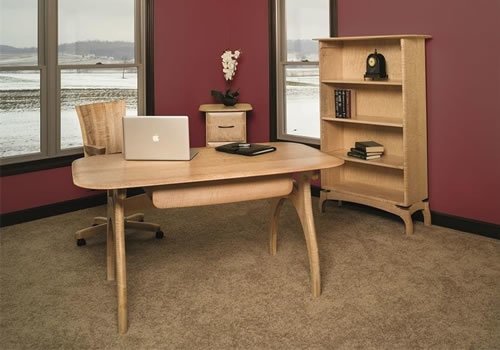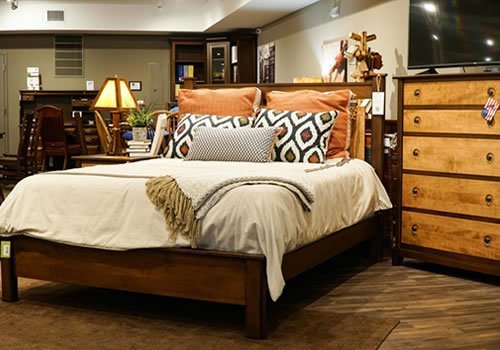Tiger Maple Furniture
Tiger maple wood is not a different species of maple. Instead it is a unique design of the grain of maple due to how the tree grows. This unusual grain pattern creates a highly coveted wood for furniture.
What is it that makes tiger maple so rare?
It’s figuring in the wood to which no pattern can compare,
Why is it so hard to be sure what you’ll see?
Because the growth that makes the pattern is up to the tree.
Qualities of Tiger Maple Furniture
Tiger maple wood is known by several names including “flame,” “quilt,” “blister,” and “birds-eye.” These names describe a bold and unique pattern that resembles stripes, waves, or flames. Tiger maple is considered an exotic wood, and the variety of patterns paired with its durable nature make it a popular choice for unique, decorative furniture designs.

Look of Tiger Maple Furniture
The patterns in tiger maple are not the normal wood grain pattern of maple wood; they occur from a distortion of the wood fibers of the tree as it grows. The fiber cells twist and move as the tree grows, making waves, and the result is called figuring or figured wood. The resulting patterns are described as “chatoyant” by some woodworkers, meaning the pattern can take on a 3-dimensional look when exposed to light.
The tiger pattern or “figuring” refers to stripes that go across the grain, while a curly pattern refers to S-shaped lines that run parallel to the grain. Some boards have more than one type of figuring present. The exotic look of tiger maple wood is a favorite for high-end custom furniture.
The colors in Tiger Maple is the same as any maple wood. Maple’s sapwood is creamy white to reddish brown and the heartwood varies from light to dark reddish brown. It has a close, fine uniform texture.

Is Tiger Maple the Same as Curly Maple?
Yes, tiger maple wood is also referred to as curly, flame, ripple, tiger stripe, quilt, blister, bird’s eye, fiddleback or ripple maple. All these titles refer to the pattern on the wood that can take on the look of stripes, waves or flames.
Uses of Tiger Maple
Tiger maple’s strength and durability combined with its unique patterns make it ideal for:
- Furniture
- Cabinets
- Doors
- Flooring
- Gun stocks
- Musical instruments like violins and guitars
- Knife handles
The Janka Hardness Rating* for curly maple that comes from red leaf maple trees is 950, putting it right near the strength and durability you can rely on from cherry wood.
*The Janka Rating is used to test relative hardness of wood. It measures the amount of force required to embed a 0.444” steel ball into the wood to half of the ball’s diameter.
Working with Tiger Maple Wood
Because tiger maple has such a unique pattern and offers durability, it is sought after by woodworkers looking to create decorative pieces of furniture. It is fairly easy to work with hand or machine tools. It turns, glues and finishes well, and the finish will enhance the pattern. Light colored tiger maple looks gorgeous in a clear or natural finish as well as with tung or boiled linseed oil. It can also be stained to display a gorgeous finish.
Where Tiger Maple Grows
There are dozens of different types of maple trees. Tiger or curly maple can be found in different species of maples when it occurs, like red maple trees, big leaf maples and sugar maples, but tiger maple tends to be found in red maple trees (acer rubrum). Red maples grow in the eastern and central United States and Canada. Red maple trees can grow from 90 to 120 feet tall with trunks reaching a width of roughly 2 ½ feet.
Tiger maple patterns are not found in all maple trees and actually occur in less than 5 percent of common maple trees. The unpredictability combined with the beauty of the pattern make tiger maple wood a prized wood type by woodworkers.
Cost of Tiger Maple
The following factors contribute to a higher price tag for tiger maple furniture.
- The intensity and consistency of the figuring.
- The color, with lighter shades being more sought after.
- It’s considered an exotic wood.
- It’s harder to source due to its unpredictable nature.
- No two pieces are the same.
- Quarter sawing brings out more of the figuring, and the method of quarter sawing is more labor intensive.
How to Care for Tiger Maple Furniture
For tips on how to care for your exotic tiger maple furniture, please visit our Caring for Wood Furniture Page for information.
We are available to answer any questions you may have about our exotic tiger maple furniture. Please email or call a member of our team for assistance. Our toll-free number is 866-272-6773.



